Project Report: Financial Analysis and Performance of Sainsbury PLC
VerifiedAdded on 2021/10/08
|28
|8865
|43
Project
AI Summary
This project report provides a comprehensive financial analysis of Sainsbury PLC, a major UK grocery retailer. The report begins with an introduction to the company and then delves into a detailed examination of its financial information, including financial statements (balance sheet, income statement, and cash flow statement). It explores financial documents and their conclusions, followed by comparative analysis using tools such as ratio analysis, vertical analysis, and horizontal analysis. The report evaluates the needs of stakeholders and reviews the financial information to provide insights into Sainsbury's performance. The project also addresses budgeting systems, their accessibility, and importance within an organization. Finally, the project assesses the criteria for judging a proposal's viability, its strengths and weaknesses, and the viability of its expenditure, providing a complete financial overview of the company's operations and performance.
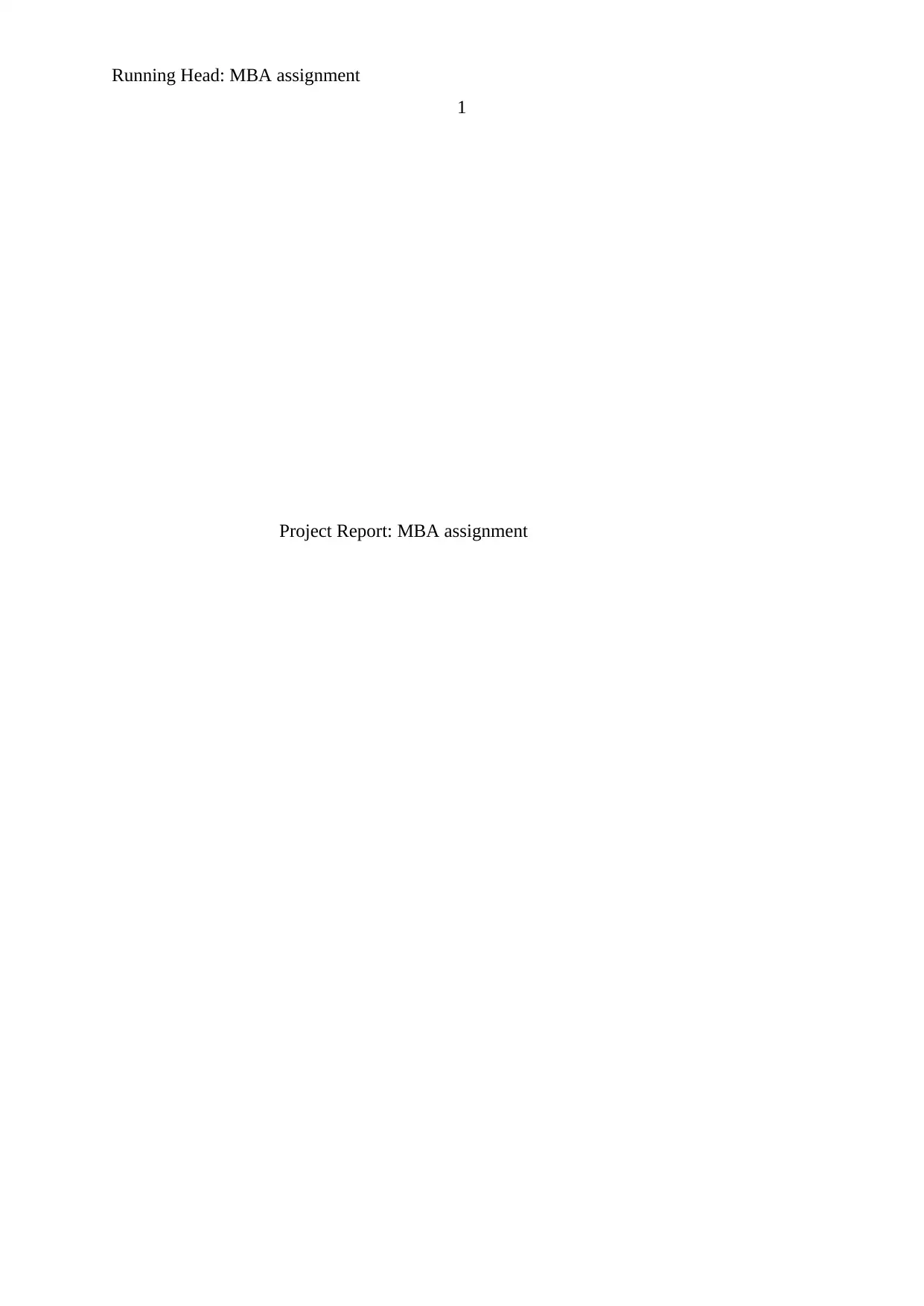
Running Head: MBA assignment
1
Project Report: MBA assignment
1
Project Report: MBA assignment
Paraphrase This Document
Need a fresh take? Get an instant paraphrase of this document with our AI Paraphraser
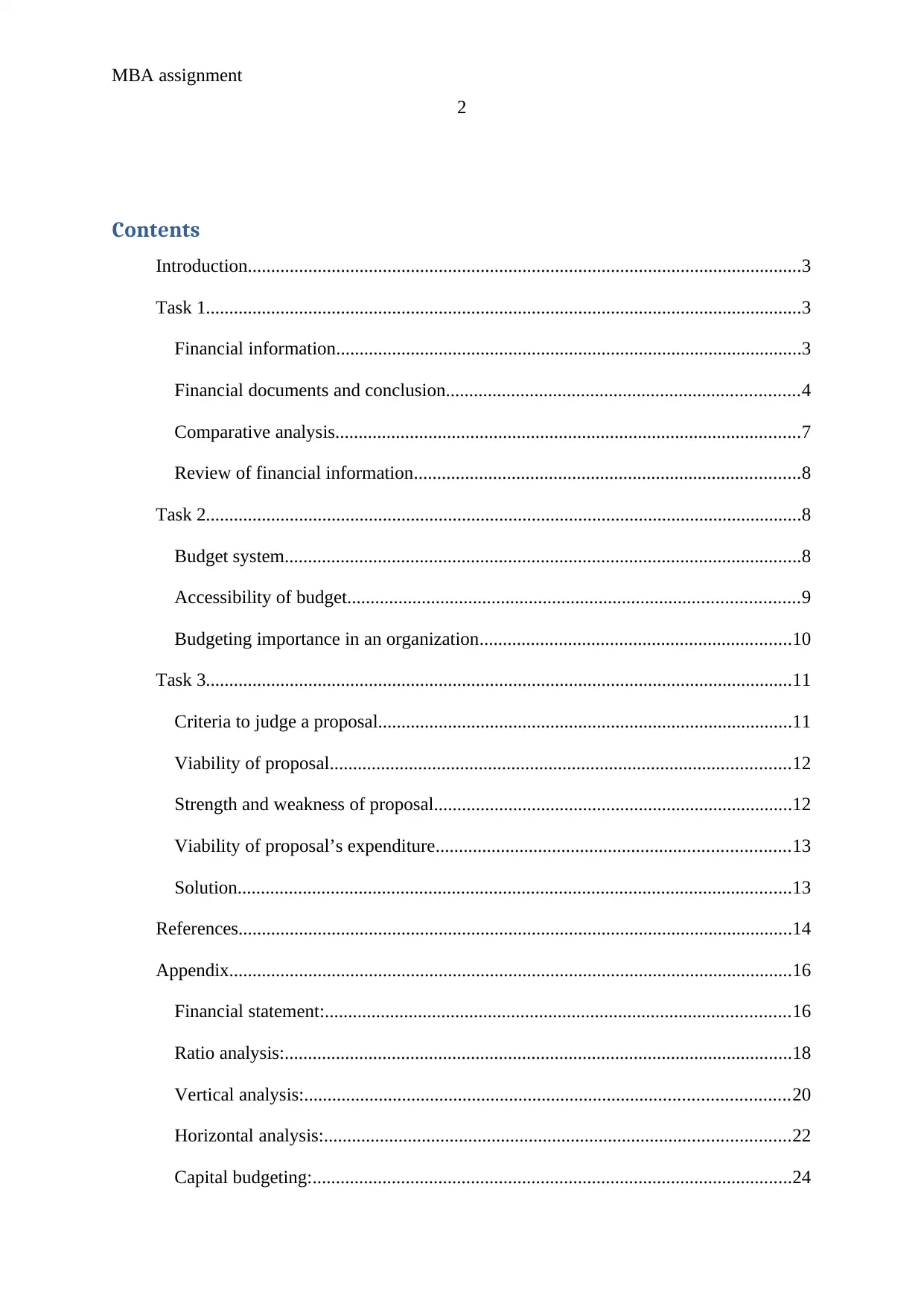
MBA assignment
2
Contents
Introduction.......................................................................................................................3
Task 1................................................................................................................................3
Financial information....................................................................................................3
Financial documents and conclusion............................................................................4
Comparative analysis....................................................................................................7
Review of financial information...................................................................................8
Task 2................................................................................................................................8
Budget system...............................................................................................................8
Accessibility of budget.................................................................................................9
Budgeting importance in an organization...................................................................10
Task 3..............................................................................................................................11
Criteria to judge a proposal.........................................................................................11
Viability of proposal...................................................................................................12
Strength and weakness of proposal.............................................................................12
Viability of proposal’s expenditure............................................................................13
Solution.......................................................................................................................13
References.......................................................................................................................14
Appendix.........................................................................................................................16
Financial statement:....................................................................................................16
Ratio analysis:.............................................................................................................18
Vertical analysis:........................................................................................................20
Horizontal analysis:....................................................................................................22
Capital budgeting:.......................................................................................................24
2
Contents
Introduction.......................................................................................................................3
Task 1................................................................................................................................3
Financial information....................................................................................................3
Financial documents and conclusion............................................................................4
Comparative analysis....................................................................................................7
Review of financial information...................................................................................8
Task 2................................................................................................................................8
Budget system...............................................................................................................8
Accessibility of budget.................................................................................................9
Budgeting importance in an organization...................................................................10
Task 3..............................................................................................................................11
Criteria to judge a proposal.........................................................................................11
Viability of proposal...................................................................................................12
Strength and weakness of proposal.............................................................................12
Viability of proposal’s expenditure............................................................................13
Solution.......................................................................................................................13
References.......................................................................................................................14
Appendix.........................................................................................................................16
Financial statement:....................................................................................................16
Ratio analysis:.............................................................................................................18
Vertical analysis:........................................................................................................20
Horizontal analysis:....................................................................................................22
Capital budgeting:.......................................................................................................24

MBA assignment
3
3
⊘ This is a preview!⊘
Do you want full access?
Subscribe today to unlock all pages.

Trusted by 1+ million students worldwide
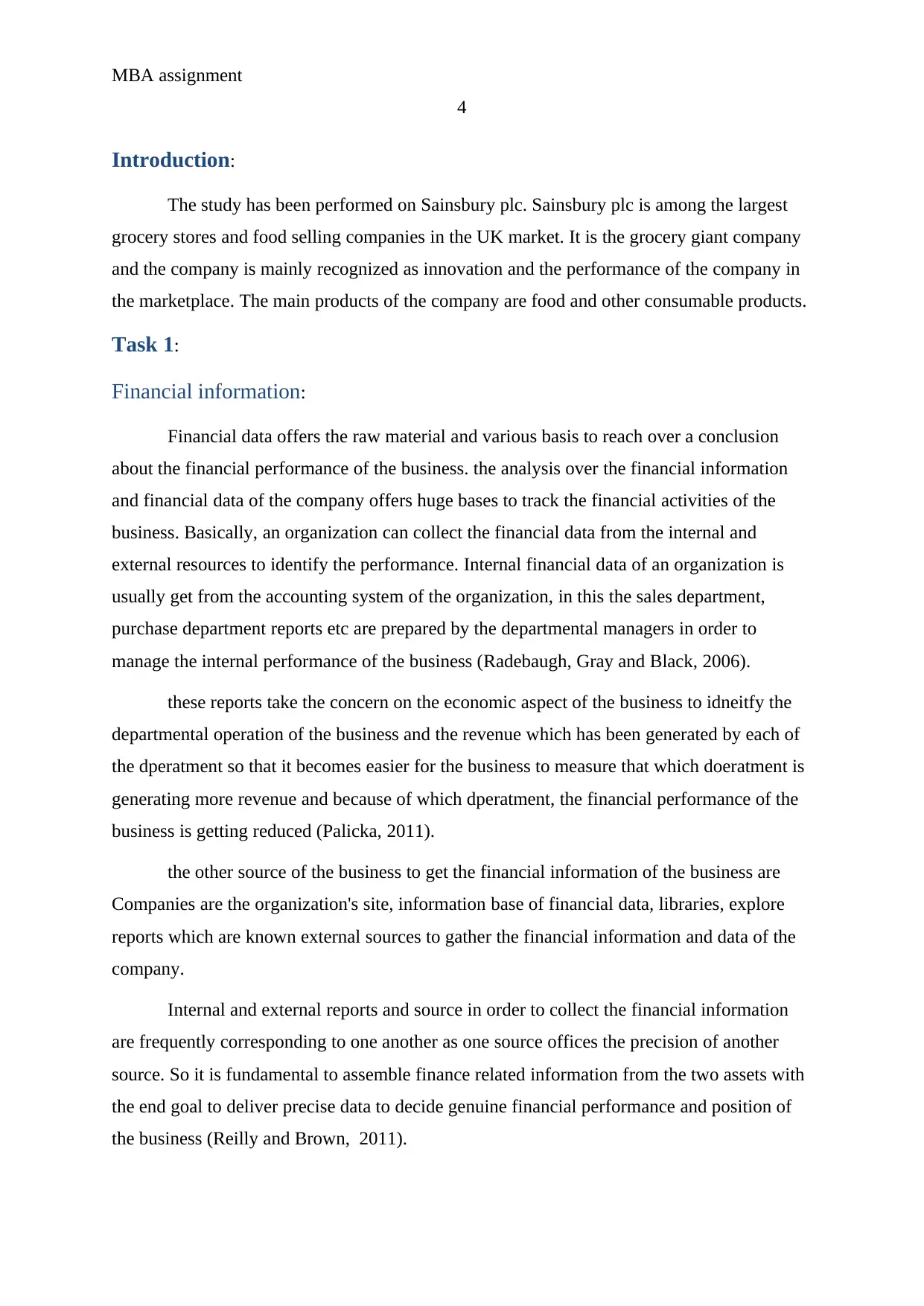
MBA assignment
4
Introduction:
The study has been performed on Sainsbury plc. Sainsbury plc is among the largest
grocery stores and food selling companies in the UK market. It is the grocery giant company
and the company is mainly recognized as innovation and the performance of the company in
the marketplace. The main products of the company are food and other consumable products.
Task 1:
Financial information:
Financial data offers the raw material and various basis to reach over a conclusion
about the financial performance of the business. the analysis over the financial information
and financial data of the company offers huge bases to track the financial activities of the
business. Basically, an organization can collect the financial data from the internal and
external resources to identify the performance. Internal financial data of an organization is
usually get from the accounting system of the organization, in this the sales department,
purchase department reports etc are prepared by the departmental managers in order to
manage the internal performance of the business (Radebaugh, Gray and Black, 2006).
these reports take the concern on the economic aspect of the business to idneitfy the
departmental operation of the business and the revenue which has been generated by each of
the dperatment so that it becomes easier for the business to measure that which doeratment is
generating more revenue and because of which dperatment, the financial performance of the
business is getting reduced (Palicka, 2011).
the other source of the business to get the financial information of the business are
Companies are the organization's site, information base of financial data, libraries, explore
reports which are known external sources to gather the financial information and data of the
company.
Internal and external reports and source in order to collect the financial information
are frequently corresponding to one another as one source offices the precision of another
source. So it is fundamental to assemble finance related information from the two assets with
the end goal to deliver precise data to decide genuine financial performance and position of
the business (Reilly and Brown, 2011).
4
Introduction:
The study has been performed on Sainsbury plc. Sainsbury plc is among the largest
grocery stores and food selling companies in the UK market. It is the grocery giant company
and the company is mainly recognized as innovation and the performance of the company in
the marketplace. The main products of the company are food and other consumable products.
Task 1:
Financial information:
Financial data offers the raw material and various basis to reach over a conclusion
about the financial performance of the business. the analysis over the financial information
and financial data of the company offers huge bases to track the financial activities of the
business. Basically, an organization can collect the financial data from the internal and
external resources to identify the performance. Internal financial data of an organization is
usually get from the accounting system of the organization, in this the sales department,
purchase department reports etc are prepared by the departmental managers in order to
manage the internal performance of the business (Radebaugh, Gray and Black, 2006).
these reports take the concern on the economic aspect of the business to idneitfy the
departmental operation of the business and the revenue which has been generated by each of
the dperatment so that it becomes easier for the business to measure that which doeratment is
generating more revenue and because of which dperatment, the financial performance of the
business is getting reduced (Palicka, 2011).
the other source of the business to get the financial information of the business are
Companies are the organization's site, information base of financial data, libraries, explore
reports which are known external sources to gather the financial information and data of the
company.
Internal and external reports and source in order to collect the financial information
are frequently corresponding to one another as one source offices the precision of another
source. So it is fundamental to assemble finance related information from the two assets with
the end goal to deliver precise data to decide genuine financial performance and position of
the business (Reilly and Brown, 2011).
Paraphrase This Document
Need a fresh take? Get an instant paraphrase of this document with our AI Paraphraser
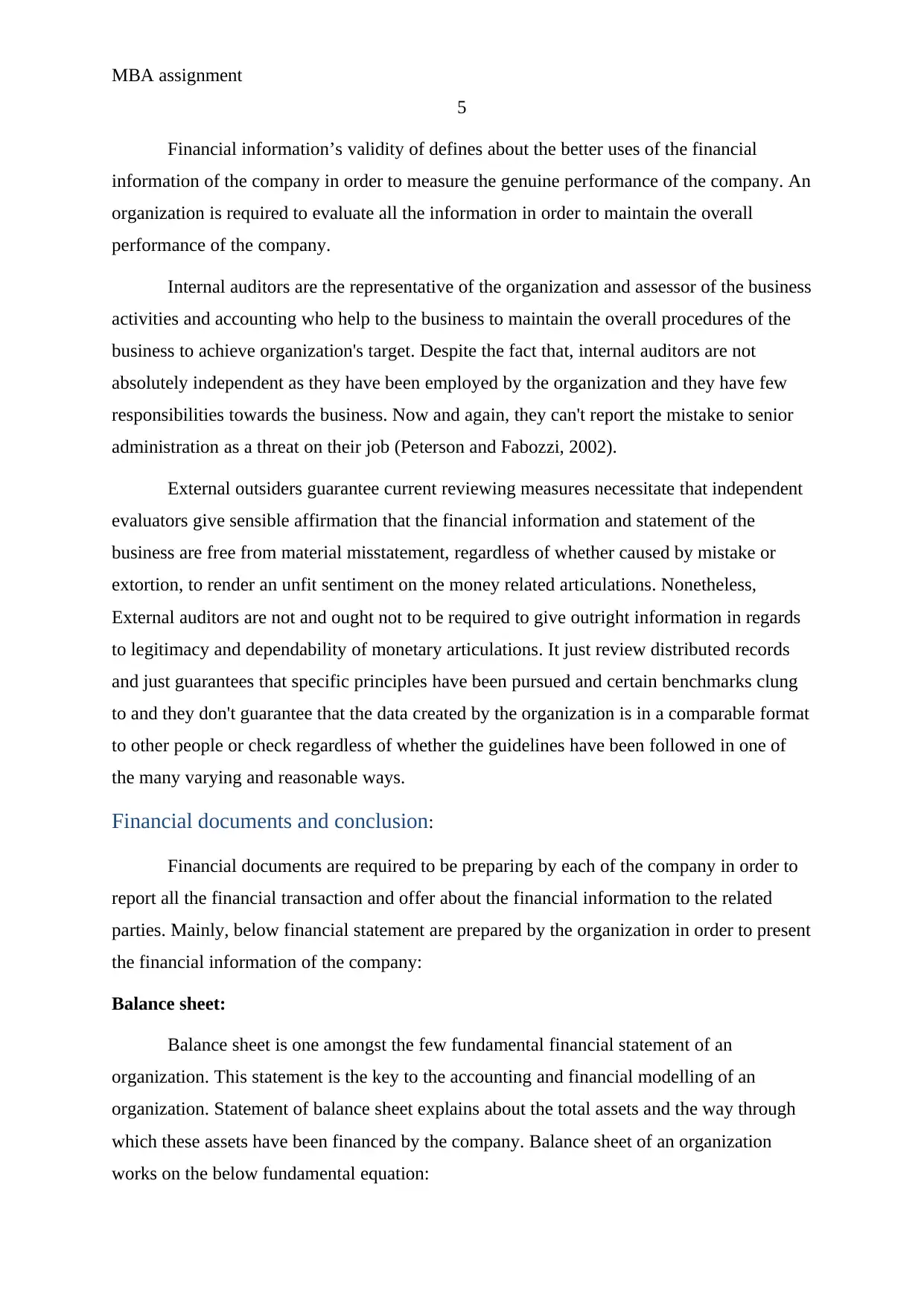
MBA assignment
5
Financial information’s validity of defines about the better uses of the financial
information of the company in order to measure the genuine performance of the company. An
organization is required to evaluate all the information in order to maintain the overall
performance of the company.
Internal auditors are the representative of the organization and assessor of the business
activities and accounting who help to the business to maintain the overall procedures of the
business to achieve organization's target. Despite the fact that, internal auditors are not
absolutely independent as they have been employed by the organization and they have few
responsibilities towards the business. Now and again, they can't report the mistake to senior
administration as a threat on their job (Peterson and Fabozzi, 2002).
External outsiders guarantee current reviewing measures necessitate that independent
evaluators give sensible affirmation that the financial information and statement of the
business are free from material misstatement, regardless of whether caused by mistake or
extortion, to render an unfit sentiment on the money related articulations. Nonetheless,
External auditors are not and ought not to be required to give outright information in regards
to legitimacy and dependability of monetary articulations. It just review distributed records
and just guarantees that specific principles have been pursued and certain benchmarks clung
to and they don't guarantee that the data created by the organization is in a comparable format
to other people or check regardless of whether the guidelines have been followed in one of
the many varying and reasonable ways.
Financial documents and conclusion:
Financial documents are required to be preparing by each of the company in order to
report all the financial transaction and offer about the financial information to the related
parties. Mainly, below financial statement are prepared by the organization in order to present
the financial information of the company:
Balance sheet:
Balance sheet is one amongst the few fundamental financial statement of an
organization. This statement is the key to the accounting and financial modelling of an
organization. Statement of balance sheet explains about the total assets and the way through
which these assets have been financed by the company. Balance sheet of an organization
works on the below fundamental equation:
5
Financial information’s validity of defines about the better uses of the financial
information of the company in order to measure the genuine performance of the company. An
organization is required to evaluate all the information in order to maintain the overall
performance of the company.
Internal auditors are the representative of the organization and assessor of the business
activities and accounting who help to the business to maintain the overall procedures of the
business to achieve organization's target. Despite the fact that, internal auditors are not
absolutely independent as they have been employed by the organization and they have few
responsibilities towards the business. Now and again, they can't report the mistake to senior
administration as a threat on their job (Peterson and Fabozzi, 2002).
External outsiders guarantee current reviewing measures necessitate that independent
evaluators give sensible affirmation that the financial information and statement of the
business are free from material misstatement, regardless of whether caused by mistake or
extortion, to render an unfit sentiment on the money related articulations. Nonetheless,
External auditors are not and ought not to be required to give outright information in regards
to legitimacy and dependability of monetary articulations. It just review distributed records
and just guarantees that specific principles have been pursued and certain benchmarks clung
to and they don't guarantee that the data created by the organization is in a comparable format
to other people or check regardless of whether the guidelines have been followed in one of
the many varying and reasonable ways.
Financial documents and conclusion:
Financial documents are required to be preparing by each of the company in order to
report all the financial transaction and offer about the financial information to the related
parties. Mainly, below financial statement are prepared by the organization in order to present
the financial information of the company:
Balance sheet:
Balance sheet is one amongst the few fundamental financial statement of an
organization. This statement is the key to the accounting and financial modelling of an
organization. Statement of balance sheet explains about the total assets and the way through
which these assets have been financed by the company. Balance sheet of an organization
works on the below fundamental equation:
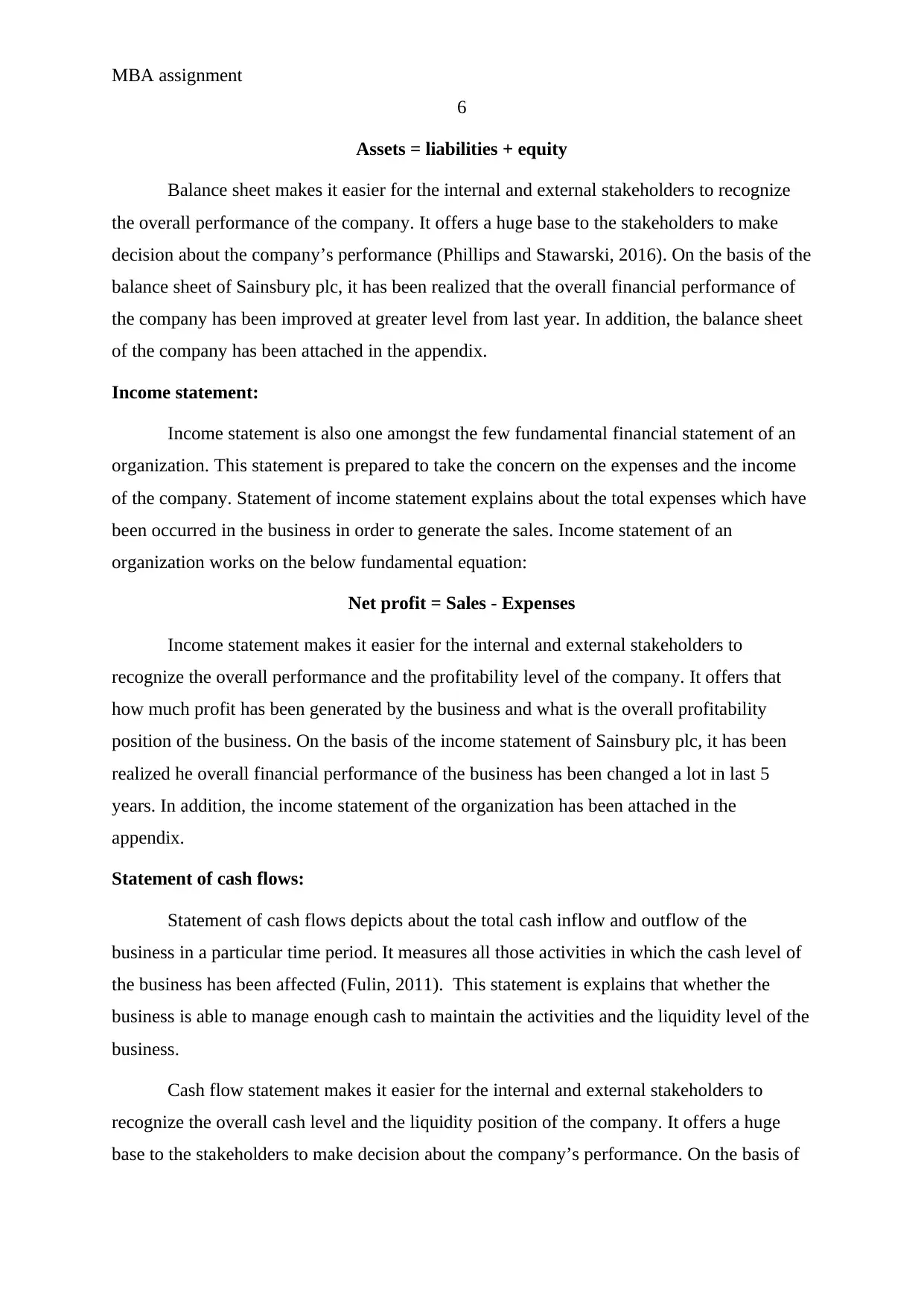
MBA assignment
6
Assets = liabilities + equity
Balance sheet makes it easier for the internal and external stakeholders to recognize
the overall performance of the company. It offers a huge base to the stakeholders to make
decision about the company’s performance (Phillips and Stawarski, 2016). On the basis of the
balance sheet of Sainsbury plc, it has been realized that the overall financial performance of
the company has been improved at greater level from last year. In addition, the balance sheet
of the company has been attached in the appendix.
Income statement:
Income statement is also one amongst the few fundamental financial statement of an
organization. This statement is prepared to take the concern on the expenses and the income
of the company. Statement of income statement explains about the total expenses which have
been occurred in the business in order to generate the sales. Income statement of an
organization works on the below fundamental equation:
Net profit = Sales - Expenses
Income statement makes it easier for the internal and external stakeholders to
recognize the overall performance and the profitability level of the company. It offers that
how much profit has been generated by the business and what is the overall profitability
position of the business. On the basis of the income statement of Sainsbury plc, it has been
realized he overall financial performance of the business has been changed a lot in last 5
years. In addition, the income statement of the organization has been attached in the
appendix.
Statement of cash flows:
Statement of cash flows depicts about the total cash inflow and outflow of the
business in a particular time period. It measures all those activities in which the cash level of
the business has been affected (Fulin, 2011). This statement is explains that whether the
business is able to manage enough cash to maintain the activities and the liquidity level of the
business.
Cash flow statement makes it easier for the internal and external stakeholders to
recognize the overall cash level and the liquidity position of the company. It offers a huge
base to the stakeholders to make decision about the company’s performance. On the basis of
6
Assets = liabilities + equity
Balance sheet makes it easier for the internal and external stakeholders to recognize
the overall performance of the company. It offers a huge base to the stakeholders to make
decision about the company’s performance (Phillips and Stawarski, 2016). On the basis of the
balance sheet of Sainsbury plc, it has been realized that the overall financial performance of
the company has been improved at greater level from last year. In addition, the balance sheet
of the company has been attached in the appendix.
Income statement:
Income statement is also one amongst the few fundamental financial statement of an
organization. This statement is prepared to take the concern on the expenses and the income
of the company. Statement of income statement explains about the total expenses which have
been occurred in the business in order to generate the sales. Income statement of an
organization works on the below fundamental equation:
Net profit = Sales - Expenses
Income statement makes it easier for the internal and external stakeholders to
recognize the overall performance and the profitability level of the company. It offers that
how much profit has been generated by the business and what is the overall profitability
position of the business. On the basis of the income statement of Sainsbury plc, it has been
realized he overall financial performance of the business has been changed a lot in last 5
years. In addition, the income statement of the organization has been attached in the
appendix.
Statement of cash flows:
Statement of cash flows depicts about the total cash inflow and outflow of the
business in a particular time period. It measures all those activities in which the cash level of
the business has been affected (Fulin, 2011). This statement is explains that whether the
business is able to manage enough cash to maintain the activities and the liquidity level of the
business.
Cash flow statement makes it easier for the internal and external stakeholders to
recognize the overall cash level and the liquidity position of the company. It offers a huge
base to the stakeholders to make decision about the company’s performance. On the basis of
⊘ This is a preview!⊘
Do you want full access?
Subscribe today to unlock all pages.

Trusted by 1+ million students worldwide
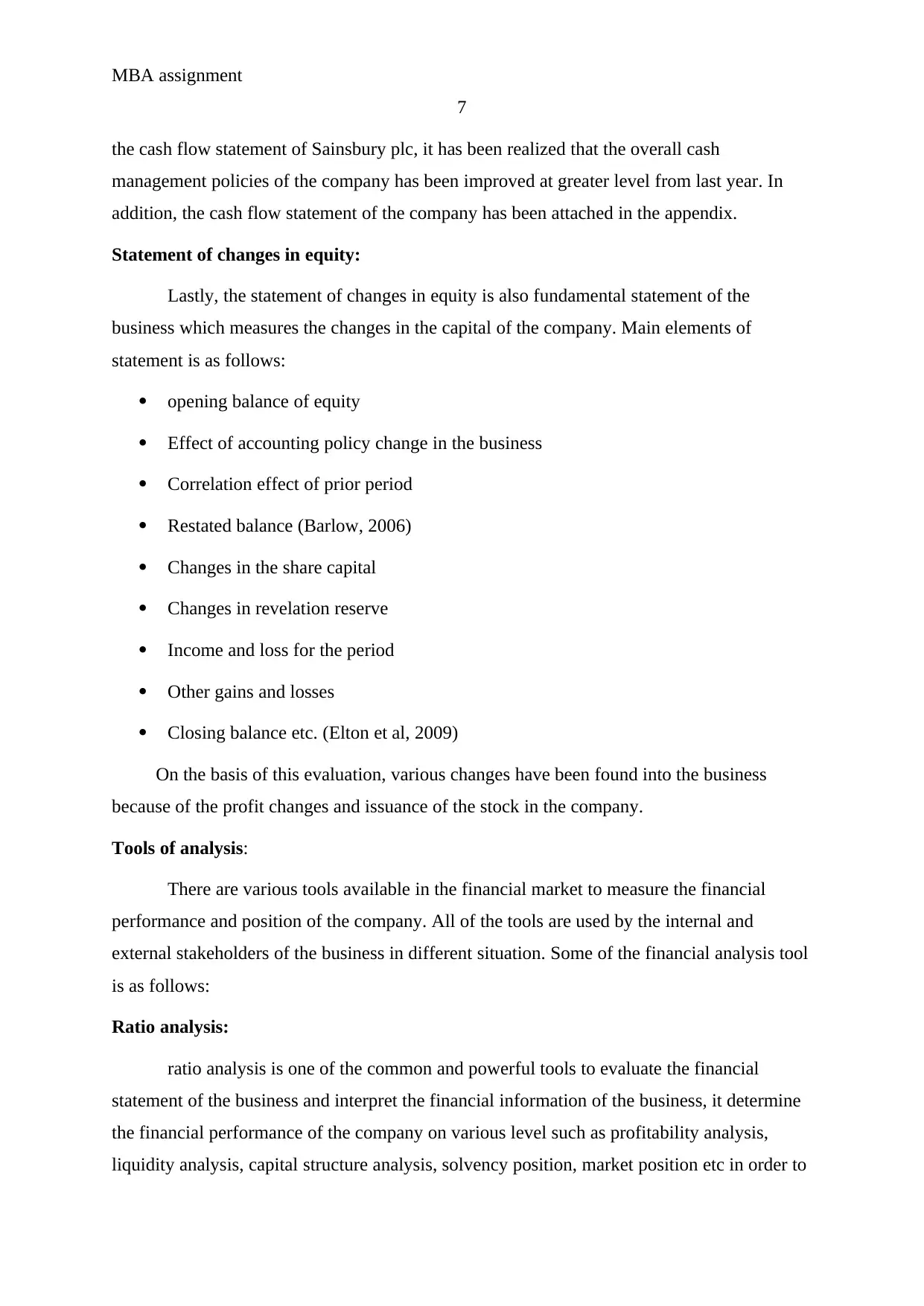
MBA assignment
7
the cash flow statement of Sainsbury plc, it has been realized that the overall cash
management policies of the company has been improved at greater level from last year. In
addition, the cash flow statement of the company has been attached in the appendix.
Statement of changes in equity:
Lastly, the statement of changes in equity is also fundamental statement of the
business which measures the changes in the capital of the company. Main elements of
statement is as follows:
opening balance of equity
Effect of accounting policy change in the business
Correlation effect of prior period
Restated balance (Barlow, 2006)
Changes in the share capital
Changes in revelation reserve
Income and loss for the period
Other gains and losses
Closing balance etc. (Elton et al, 2009)
On the basis of this evaluation, various changes have been found into the business
because of the profit changes and issuance of the stock in the company.
Tools of analysis:
There are various tools available in the financial market to measure the financial
performance and position of the company. All of the tools are used by the internal and
external stakeholders of the business in different situation. Some of the financial analysis tool
is as follows:
Ratio analysis:
ratio analysis is one of the common and powerful tools to evaluate the financial
statement of the business and interpret the financial information of the business, it determine
the financial performance of the company on various level such as profitability analysis,
liquidity analysis, capital structure analysis, solvency position, market position etc in order to
7
the cash flow statement of Sainsbury plc, it has been realized that the overall cash
management policies of the company has been improved at greater level from last year. In
addition, the cash flow statement of the company has been attached in the appendix.
Statement of changes in equity:
Lastly, the statement of changes in equity is also fundamental statement of the
business which measures the changes in the capital of the company. Main elements of
statement is as follows:
opening balance of equity
Effect of accounting policy change in the business
Correlation effect of prior period
Restated balance (Barlow, 2006)
Changes in the share capital
Changes in revelation reserve
Income and loss for the period
Other gains and losses
Closing balance etc. (Elton et al, 2009)
On the basis of this evaluation, various changes have been found into the business
because of the profit changes and issuance of the stock in the company.
Tools of analysis:
There are various tools available in the financial market to measure the financial
performance and position of the company. All of the tools are used by the internal and
external stakeholders of the business in different situation. Some of the financial analysis tool
is as follows:
Ratio analysis:
ratio analysis is one of the common and powerful tools to evaluate the financial
statement of the business and interpret the financial information of the business, it determine
the financial performance of the company on various level such as profitability analysis,
liquidity analysis, capital structure analysis, solvency position, market position etc in order to
Paraphrase This Document
Need a fresh take? Get an instant paraphrase of this document with our AI Paraphraser
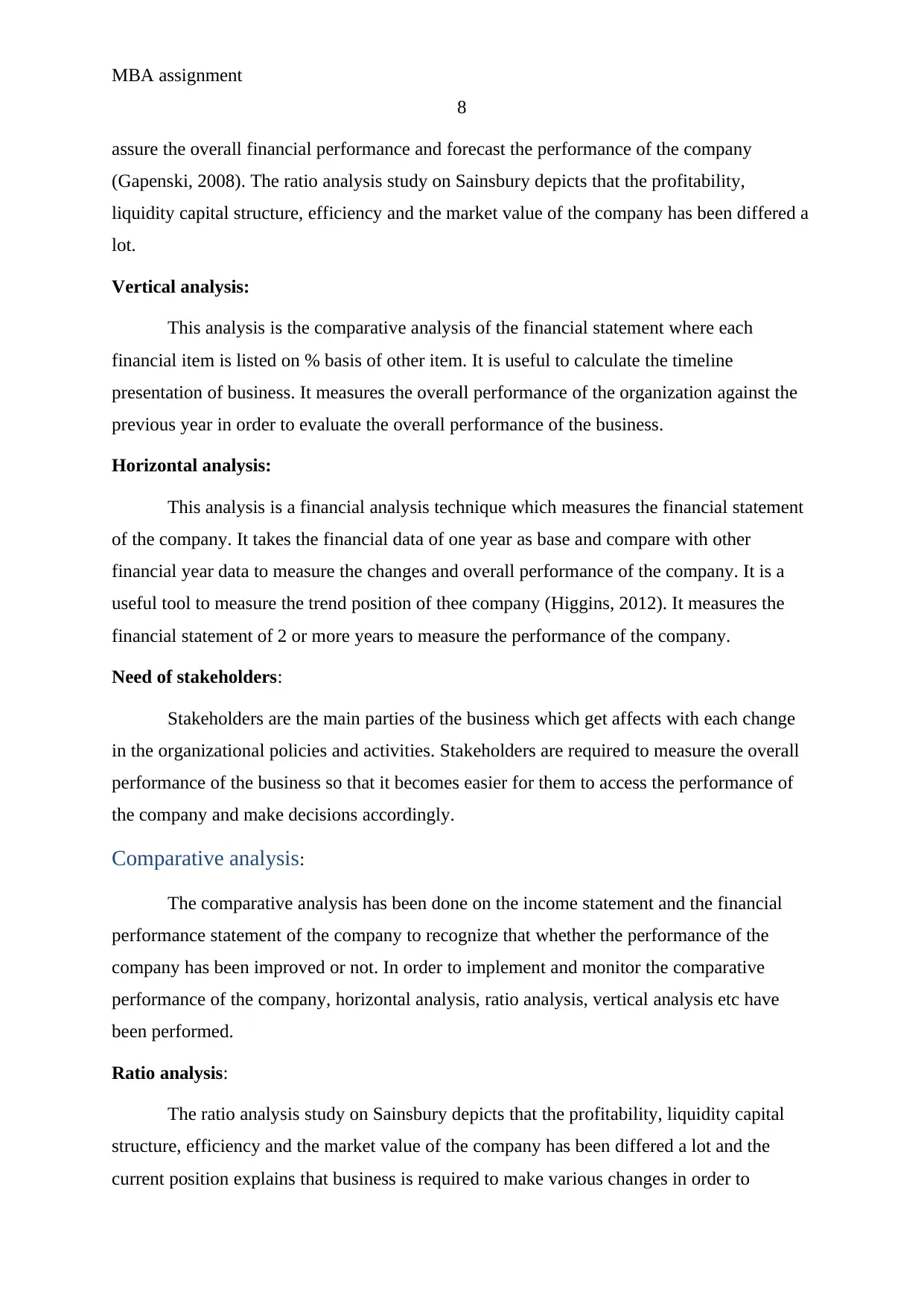
MBA assignment
8
assure the overall financial performance and forecast the performance of the company
(Gapenski, 2008). The ratio analysis study on Sainsbury depicts that the profitability,
liquidity capital structure, efficiency and the market value of the company has been differed a
lot.
Vertical analysis:
This analysis is the comparative analysis of the financial statement where each
financial item is listed on % basis of other item. It is useful to calculate the timeline
presentation of business. It measures the overall performance of the organization against the
previous year in order to evaluate the overall performance of the business.
Horizontal analysis:
This analysis is a financial analysis technique which measures the financial statement
of the company. It takes the financial data of one year as base and compare with other
financial year data to measure the changes and overall performance of the company. It is a
useful tool to measure the trend position of thee company (Higgins, 2012). It measures the
financial statement of 2 or more years to measure the performance of the company.
Need of stakeholders:
Stakeholders are the main parties of the business which get affects with each change
in the organizational policies and activities. Stakeholders are required to measure the overall
performance of the business so that it becomes easier for them to access the performance of
the company and make decisions accordingly.
Comparative analysis:
The comparative analysis has been done on the income statement and the financial
performance statement of the company to recognize that whether the performance of the
company has been improved or not. In order to implement and monitor the comparative
performance of the company, horizontal analysis, ratio analysis, vertical analysis etc have
been performed.
Ratio analysis:
The ratio analysis study on Sainsbury depicts that the profitability, liquidity capital
structure, efficiency and the market value of the company has been differed a lot and the
current position explains that business is required to make various changes in order to
8
assure the overall financial performance and forecast the performance of the company
(Gapenski, 2008). The ratio analysis study on Sainsbury depicts that the profitability,
liquidity capital structure, efficiency and the market value of the company has been differed a
lot.
Vertical analysis:
This analysis is the comparative analysis of the financial statement where each
financial item is listed on % basis of other item. It is useful to calculate the timeline
presentation of business. It measures the overall performance of the organization against the
previous year in order to evaluate the overall performance of the business.
Horizontal analysis:
This analysis is a financial analysis technique which measures the financial statement
of the company. It takes the financial data of one year as base and compare with other
financial year data to measure the changes and overall performance of the company. It is a
useful tool to measure the trend position of thee company (Higgins, 2012). It measures the
financial statement of 2 or more years to measure the performance of the company.
Need of stakeholders:
Stakeholders are the main parties of the business which get affects with each change
in the organizational policies and activities. Stakeholders are required to measure the overall
performance of the business so that it becomes easier for them to access the performance of
the company and make decisions accordingly.
Comparative analysis:
The comparative analysis has been done on the income statement and the financial
performance statement of the company to recognize that whether the performance of the
company has been improved or not. In order to implement and monitor the comparative
performance of the company, horizontal analysis, ratio analysis, vertical analysis etc have
been performed.
Ratio analysis:
The ratio analysis study on Sainsbury depicts that the profitability, liquidity capital
structure, efficiency and the market value of the company has been differed a lot and the
current position explains that business is required to make various changes in order to
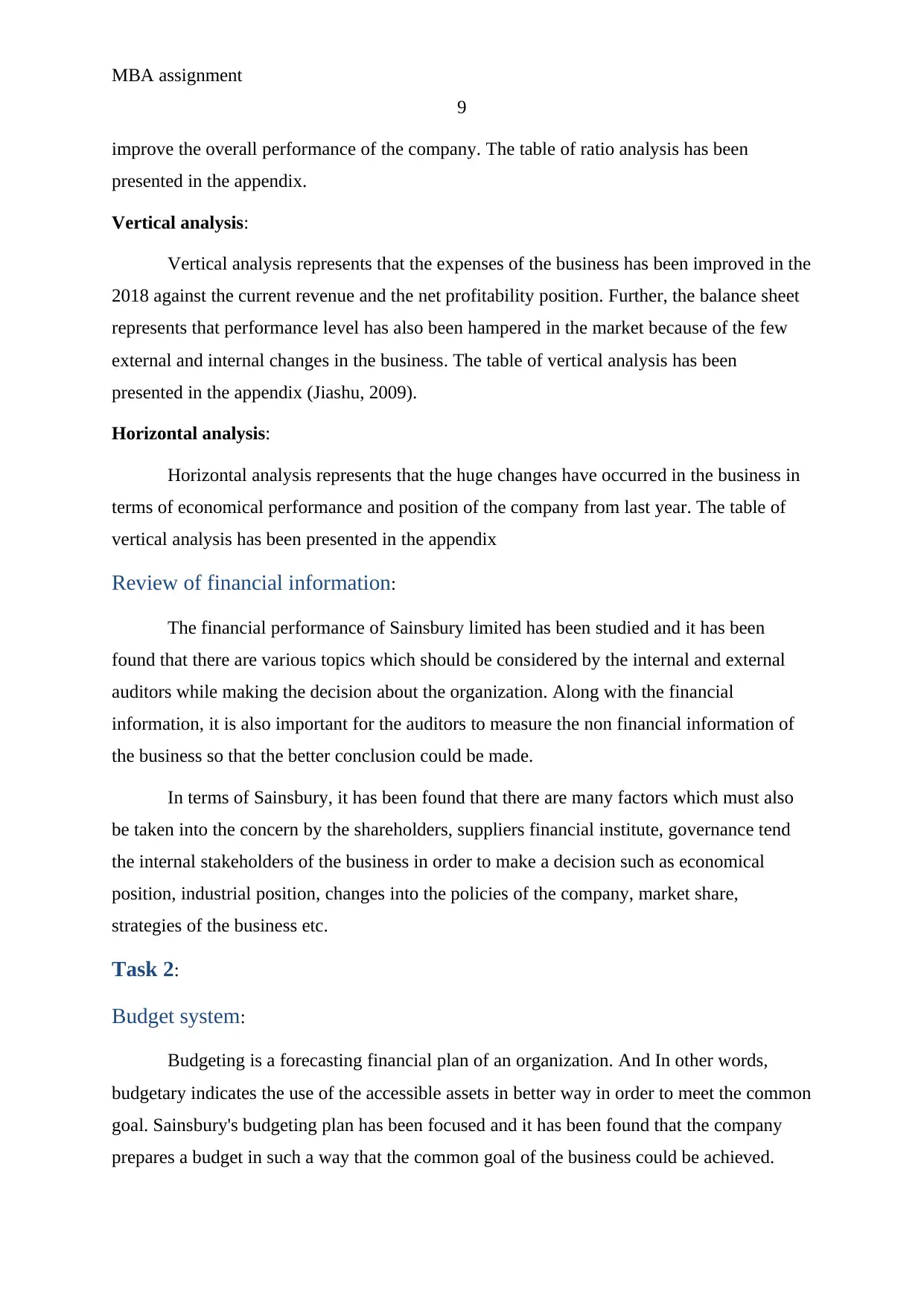
MBA assignment
9
improve the overall performance of the company. The table of ratio analysis has been
presented in the appendix.
Vertical analysis:
Vertical analysis represents that the expenses of the business has been improved in the
2018 against the current revenue and the net profitability position. Further, the balance sheet
represents that performance level has also been hampered in the market because of the few
external and internal changes in the business. The table of vertical analysis has been
presented in the appendix (Jiashu, 2009).
Horizontal analysis:
Horizontal analysis represents that the huge changes have occurred in the business in
terms of economical performance and position of the company from last year. The table of
vertical analysis has been presented in the appendix
Review of financial information:
The financial performance of Sainsbury limited has been studied and it has been
found that there are various topics which should be considered by the internal and external
auditors while making the decision about the organization. Along with the financial
information, it is also important for the auditors to measure the non financial information of
the business so that the better conclusion could be made.
In terms of Sainsbury, it has been found that there are many factors which must also
be taken into the concern by the shareholders, suppliers financial institute, governance tend
the internal stakeholders of the business in order to make a decision such as economical
position, industrial position, changes into the policies of the company, market share,
strategies of the business etc.
Task 2:
Budget system:
Budgeting is a forecasting financial plan of an organization. And In other words,
budgetary indicates the use of the accessible assets in better way in order to meet the common
goal. Sainsbury's budgeting plan has been focused and it has been found that the company
prepares a budget in such a way that the common goal of the business could be achieved.
9
improve the overall performance of the company. The table of ratio analysis has been
presented in the appendix.
Vertical analysis:
Vertical analysis represents that the expenses of the business has been improved in the
2018 against the current revenue and the net profitability position. Further, the balance sheet
represents that performance level has also been hampered in the market because of the few
external and internal changes in the business. The table of vertical analysis has been
presented in the appendix (Jiashu, 2009).
Horizontal analysis:
Horizontal analysis represents that the huge changes have occurred in the business in
terms of economical performance and position of the company from last year. The table of
vertical analysis has been presented in the appendix
Review of financial information:
The financial performance of Sainsbury limited has been studied and it has been
found that there are various topics which should be considered by the internal and external
auditors while making the decision about the organization. Along with the financial
information, it is also important for the auditors to measure the non financial information of
the business so that the better conclusion could be made.
In terms of Sainsbury, it has been found that there are many factors which must also
be taken into the concern by the shareholders, suppliers financial institute, governance tend
the internal stakeholders of the business in order to make a decision such as economical
position, industrial position, changes into the policies of the company, market share,
strategies of the business etc.
Task 2:
Budget system:
Budgeting is a forecasting financial plan of an organization. And In other words,
budgetary indicates the use of the accessible assets in better way in order to meet the common
goal. Sainsbury's budgeting plan has been focused and it has been found that the company
prepares a budget in such a way that the common goal of the business could be achieved.
⊘ This is a preview!⊘
Do you want full access?
Subscribe today to unlock all pages.

Trusted by 1+ million students worldwide
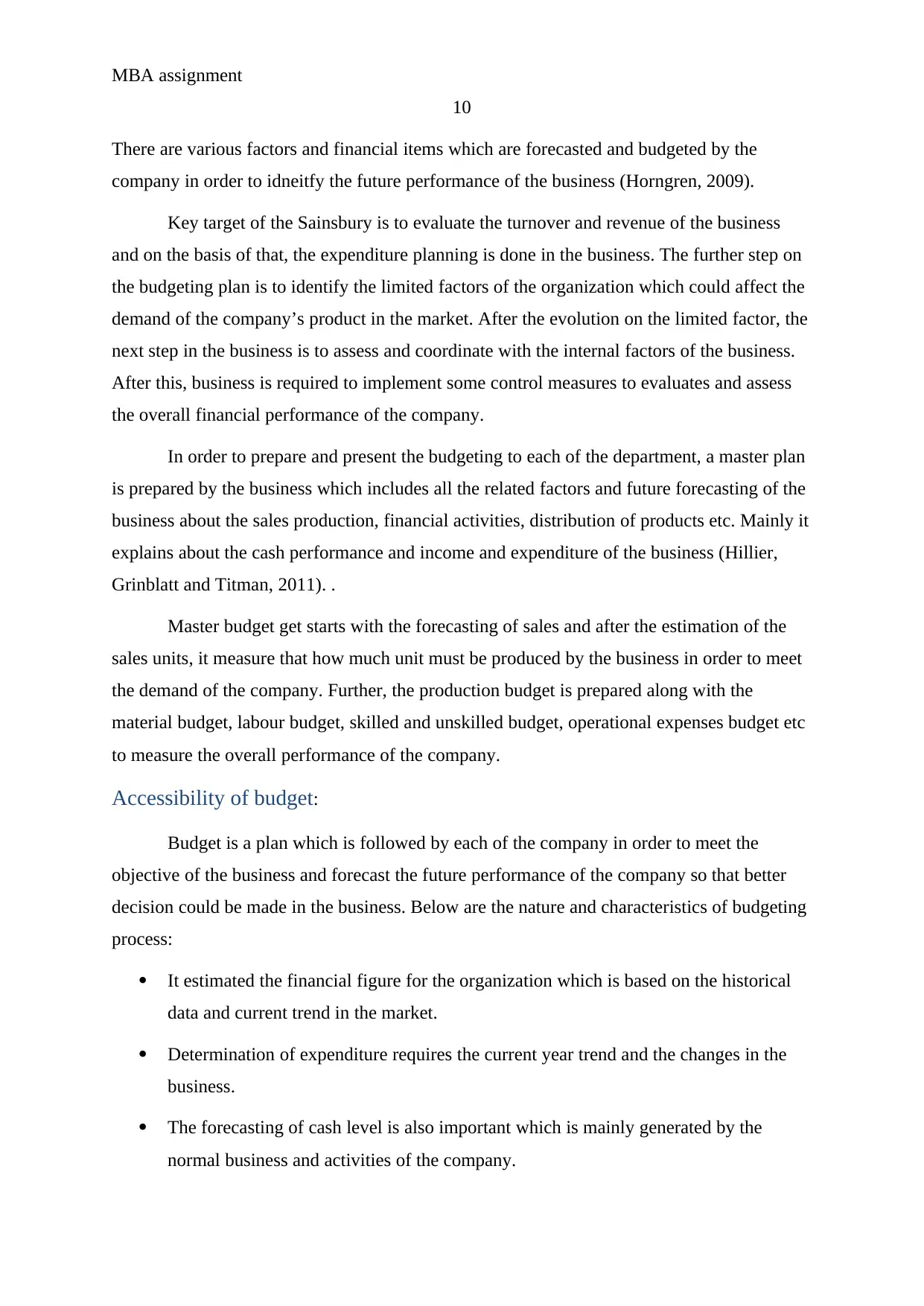
MBA assignment
10
There are various factors and financial items which are forecasted and budgeted by the
company in order to idneitfy the future performance of the business (Horngren, 2009).
Key target of the Sainsbury is to evaluate the turnover and revenue of the business
and on the basis of that, the expenditure planning is done in the business. The further step on
the budgeting plan is to identify the limited factors of the organization which could affect the
demand of the company’s product in the market. After the evolution on the limited factor, the
next step in the business is to assess and coordinate with the internal factors of the business.
After this, business is required to implement some control measures to evaluates and assess
the overall financial performance of the company.
In order to prepare and present the budgeting to each of the department, a master plan
is prepared by the business which includes all the related factors and future forecasting of the
business about the sales production, financial activities, distribution of products etc. Mainly it
explains about the cash performance and income and expenditure of the business (Hillier,
Grinblatt and Titman, 2011). .
Master budget get starts with the forecasting of sales and after the estimation of the
sales units, it measure that how much unit must be produced by the business in order to meet
the demand of the company. Further, the production budget is prepared along with the
material budget, labour budget, skilled and unskilled budget, operational expenses budget etc
to measure the overall performance of the company.
Accessibility of budget:
Budget is a plan which is followed by each of the company in order to meet the
objective of the business and forecast the future performance of the company so that better
decision could be made in the business. Below are the nature and characteristics of budgeting
process:
It estimated the financial figure for the organization which is based on the historical
data and current trend in the market.
Determination of expenditure requires the current year trend and the changes in the
business.
The forecasting of cash level is also important which is mainly generated by the
normal business and activities of the company.
10
There are various factors and financial items which are forecasted and budgeted by the
company in order to idneitfy the future performance of the business (Horngren, 2009).
Key target of the Sainsbury is to evaluate the turnover and revenue of the business
and on the basis of that, the expenditure planning is done in the business. The further step on
the budgeting plan is to identify the limited factors of the organization which could affect the
demand of the company’s product in the market. After the evolution on the limited factor, the
next step in the business is to assess and coordinate with the internal factors of the business.
After this, business is required to implement some control measures to evaluates and assess
the overall financial performance of the company.
In order to prepare and present the budgeting to each of the department, a master plan
is prepared by the business which includes all the related factors and future forecasting of the
business about the sales production, financial activities, distribution of products etc. Mainly it
explains about the cash performance and income and expenditure of the business (Hillier,
Grinblatt and Titman, 2011). .
Master budget get starts with the forecasting of sales and after the estimation of the
sales units, it measure that how much unit must be produced by the business in order to meet
the demand of the company. Further, the production budget is prepared along with the
material budget, labour budget, skilled and unskilled budget, operational expenses budget etc
to measure the overall performance of the company.
Accessibility of budget:
Budget is a plan which is followed by each of the company in order to meet the
objective of the business and forecast the future performance of the company so that better
decision could be made in the business. Below are the nature and characteristics of budgeting
process:
It estimated the financial figure for the organization which is based on the historical
data and current trend in the market.
Determination of expenditure requires the current year trend and the changes in the
business.
The forecasting of cash level is also important which is mainly generated by the
normal business and activities of the company.
Paraphrase This Document
Need a fresh take? Get an instant paraphrase of this document with our AI Paraphraser
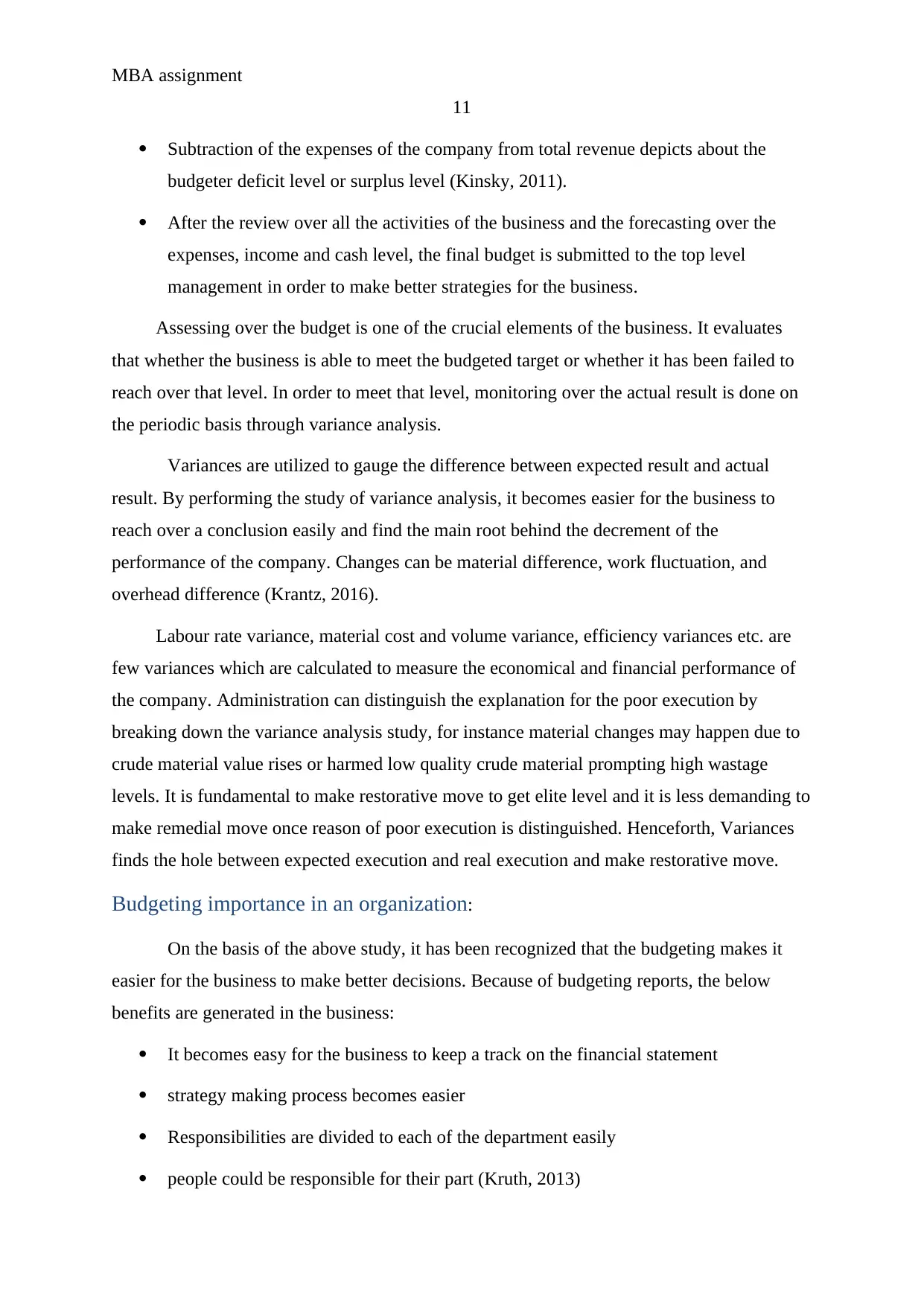
MBA assignment
11
Subtraction of the expenses of the company from total revenue depicts about the
budgeter deficit level or surplus level (Kinsky, 2011).
After the review over all the activities of the business and the forecasting over the
expenses, income and cash level, the final budget is submitted to the top level
management in order to make better strategies for the business.
Assessing over the budget is one of the crucial elements of the business. It evaluates
that whether the business is able to meet the budgeted target or whether it has been failed to
reach over that level. In order to meet that level, monitoring over the actual result is done on
the periodic basis through variance analysis.
Variances are utilized to gauge the difference between expected result and actual
result. By performing the study of variance analysis, it becomes easier for the business to
reach over a conclusion easily and find the main root behind the decrement of the
performance of the company. Changes can be material difference, work fluctuation, and
overhead difference (Krantz, 2016).
Labour rate variance, material cost and volume variance, efficiency variances etc. are
few variances which are calculated to measure the economical and financial performance of
the company. Administration can distinguish the explanation for the poor execution by
breaking down the variance analysis study, for instance material changes may happen due to
crude material value rises or harmed low quality crude material prompting high wastage
levels. It is fundamental to make restorative move to get elite level and it is less demanding to
make remedial move once reason of poor execution is distinguished. Henceforth, Variances
finds the hole between expected execution and real execution and make restorative move.
Budgeting importance in an organization:
On the basis of the above study, it has been recognized that the budgeting makes it
easier for the business to make better decisions. Because of budgeting reports, the below
benefits are generated in the business:
It becomes easy for the business to keep a track on the financial statement
strategy making process becomes easier
Responsibilities are divided to each of the department easily
people could be responsible for their part (Kruth, 2013)
11
Subtraction of the expenses of the company from total revenue depicts about the
budgeter deficit level or surplus level (Kinsky, 2011).
After the review over all the activities of the business and the forecasting over the
expenses, income and cash level, the final budget is submitted to the top level
management in order to make better strategies for the business.
Assessing over the budget is one of the crucial elements of the business. It evaluates
that whether the business is able to meet the budgeted target or whether it has been failed to
reach over that level. In order to meet that level, monitoring over the actual result is done on
the periodic basis through variance analysis.
Variances are utilized to gauge the difference between expected result and actual
result. By performing the study of variance analysis, it becomes easier for the business to
reach over a conclusion easily and find the main root behind the decrement of the
performance of the company. Changes can be material difference, work fluctuation, and
overhead difference (Krantz, 2016).
Labour rate variance, material cost and volume variance, efficiency variances etc. are
few variances which are calculated to measure the economical and financial performance of
the company. Administration can distinguish the explanation for the poor execution by
breaking down the variance analysis study, for instance material changes may happen due to
crude material value rises or harmed low quality crude material prompting high wastage
levels. It is fundamental to make restorative move to get elite level and it is less demanding to
make remedial move once reason of poor execution is distinguished. Henceforth, Variances
finds the hole between expected execution and real execution and make restorative move.
Budgeting importance in an organization:
On the basis of the above study, it has been recognized that the budgeting makes it
easier for the business to make better decisions. Because of budgeting reports, the below
benefits are generated in the business:
It becomes easy for the business to keep a track on the financial statement
strategy making process becomes easier
Responsibilities are divided to each of the department easily
people could be responsible for their part (Kruth, 2013)
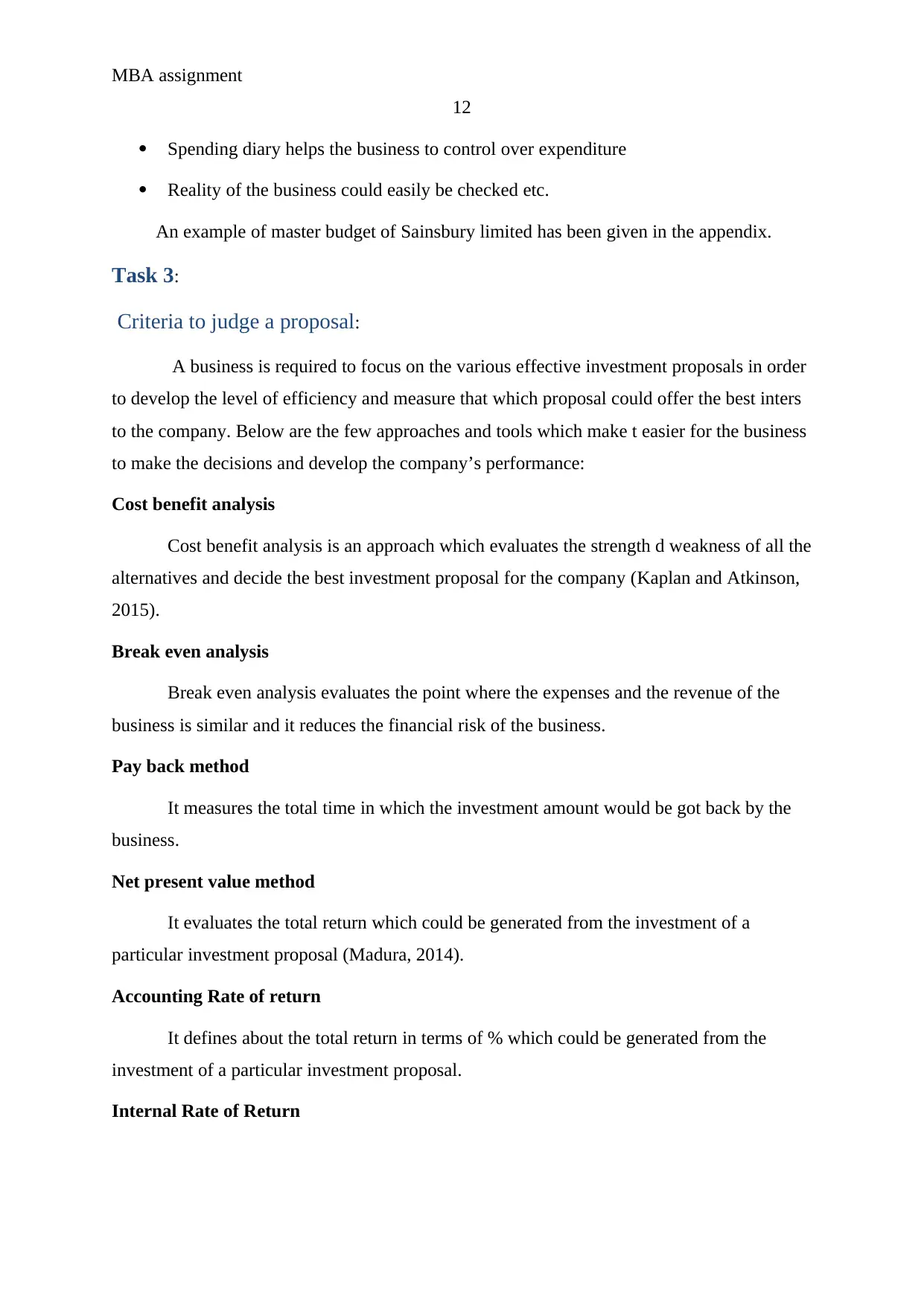
MBA assignment
12
Spending diary helps the business to control over expenditure
Reality of the business could easily be checked etc.
An example of master budget of Sainsbury limited has been given in the appendix.
Task 3:
Criteria to judge a proposal:
A business is required to focus on the various effective investment proposals in order
to develop the level of efficiency and measure that which proposal could offer the best inters
to the company. Below are the few approaches and tools which make t easier for the business
to make the decisions and develop the company’s performance:
Cost benefit analysis
Cost benefit analysis is an approach which evaluates the strength d weakness of all the
alternatives and decide the best investment proposal for the company (Kaplan and Atkinson,
2015).
Break even analysis
Break even analysis evaluates the point where the expenses and the revenue of the
business is similar and it reduces the financial risk of the business.
Pay back method
It measures the total time in which the investment amount would be got back by the
business.
Net present value method
It evaluates the total return which could be generated from the investment of a
particular investment proposal (Madura, 2014).
Accounting Rate of return
It defines about the total return in terms of % which could be generated from the
investment of a particular investment proposal.
Internal Rate of Return
12
Spending diary helps the business to control over expenditure
Reality of the business could easily be checked etc.
An example of master budget of Sainsbury limited has been given in the appendix.
Task 3:
Criteria to judge a proposal:
A business is required to focus on the various effective investment proposals in order
to develop the level of efficiency and measure that which proposal could offer the best inters
to the company. Below are the few approaches and tools which make t easier for the business
to make the decisions and develop the company’s performance:
Cost benefit analysis
Cost benefit analysis is an approach which evaluates the strength d weakness of all the
alternatives and decide the best investment proposal for the company (Kaplan and Atkinson,
2015).
Break even analysis
Break even analysis evaluates the point where the expenses and the revenue of the
business is similar and it reduces the financial risk of the business.
Pay back method
It measures the total time in which the investment amount would be got back by the
business.
Net present value method
It evaluates the total return which could be generated from the investment of a
particular investment proposal (Madura, 2014).
Accounting Rate of return
It defines about the total return in terms of % which could be generated from the
investment of a particular investment proposal.
Internal Rate of Return
⊘ This is a preview!⊘
Do you want full access?
Subscribe today to unlock all pages.

Trusted by 1+ million students worldwide
1 out of 28
Related Documents
Your All-in-One AI-Powered Toolkit for Academic Success.
+13062052269
info@desklib.com
Available 24*7 on WhatsApp / Email
![[object Object]](/_next/static/media/star-bottom.7253800d.svg)
Unlock your academic potential
Copyright © 2020–2025 A2Z Services. All Rights Reserved. Developed and managed by ZUCOL.





